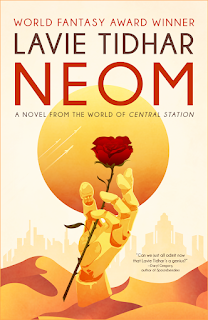And some are about ideas or wordplay or, sadly, making the next payment on the yacht, but let's leave those other options aside for now.
Neom has a story, but it's not a book about its story. It's about a place, and a group of people who live in or come to that place. It's also, not to blow up my schema too much, a book deeply in conversation with earlier SF stories - to give just one example, there's a mechanical intelligence called "a Fondly" and you can guess what kinds of mischief it gets up to when the temperature gets too hot.
Neom is the place: I gather that it is a real-world place, but just barely so right now, a dream of a city on the Red Sea, deep in the Arabian desert. In Lavie Tidhar's novel, we're several centuries in the future: how far, exactly, isn't clear, by design. But this is the same era as his Central Station, and numerous other stories.
There have been wars - big, transformative, horrible wars - but they are over. Earth is peaceful and prosperous, though individuals are not always so. Humans are dominant, and the only group of sentients still generating new physical sophonts - with an asterisk for the digital-only Others of the Conversation, who touch the physical universe occasionally and lightly - but those rambunctious past centuries generated robots (humaniform) and war machines in other shapes (Leviathans in the seas, mecha, giant sandworms, and so on into smaller sizes), at least one kind of speaking, uplifted animal, and the cyborged robotniks. All of those are still around, here and there - some worn out or nearly-destroyed, some damaged (physically, psychologically, both) and solitary in the deep desert, many departed for Mars and the Outer System, some living among baseline humans as just more neighbors.
It is a big, complex, deeply science-fictional universe Tidhar sets his stories in, and any story only shows small pieces of that universe, with glimpses and hints of other pieces and places. Neom, even more than Central Station, is a book about being a SF novel, about being set in this specific SF world and at the same time referencing or ringing changes on a dozen older relevant books and stories. It's a modern, smart SF novel for people who have read a lot of SF and unabashedly want to read more of it.
Neom in this fictional world is a bustling, rich, forward-looking city, very lightly ruled and changing every moment to stay on the cutting edge of every possible thing it could be on the cutting edge of. But our viewpoints are not on the bustlers, those at the bleeding edge, but the ones a bit slower, a bit more left behind, a bit more out of place in the eternal Now of Neom.
Nasir is a policeman, a shurta - a good one, devoted to his duty, in this place where the police don't have a lot to do, for laissez-faire and rich & peaceful reasons.
Mariam works a dozen small jobs, cleaning apartments and working in a shop and so forth: she's got the striving, hard-working side of Neom to heart, though she's not the kind who ever will get ahead or be on the bleeding edge of anything.
The robot is an enigma, an old war machine come to Neom for unexplained purposes, giving no name and no explanation.
Salah is a boy, the sole survivor of the Abu-Ala extended family of scavengers and traders. His whole tribe was wiped out while excavating the dead city of Dahab, where a terrorartist [1] set off a time-dilation bomb back in the days of the wars, a bomb that is still exploding now, in slow-motion, inside a bubble of frozen time. He came out of that explosion alone, with a treasure that he hopes is valuable enough to get him off Earth forever, to get him to a new life on Mars.
Those are most of the elements of this short book: I could also mention Anubis, the talking jackal Salah takes up with, the terrorartist Nasu, and a couple of important secondary characters: the trader in old technology Mukhtar and Sharif, skilled at rebuilding ancient tech and once apprentice to Nasu.
Some of those people are in Neom already and some are heading to Neom. Because of them, something that has been asleep in the desert for centuries will wake up, and the equally old plans of Nasu will start to move forward again. None of that sounds positive; it's not supposed to.
I won't tell you how Neom ends, only that it ends well. This is a smart, open-hearted, short SF novel deeply steeped in the history of the robot and mechanical man in SF, and that has plenty of its own changes to ring on those ideas, set, as I said, in a deep, complex, interesting universe of its own. If any of that sounds appealing, you definitely should read it.
[1] This is just what it sounds like: an individual that uses the elements of terror - explosives, death, fear, destruction - to create a site-specific "art" installation. Think of it as Damien Hirst's shark, but in real time with human beings.

No comments:
Post a Comment